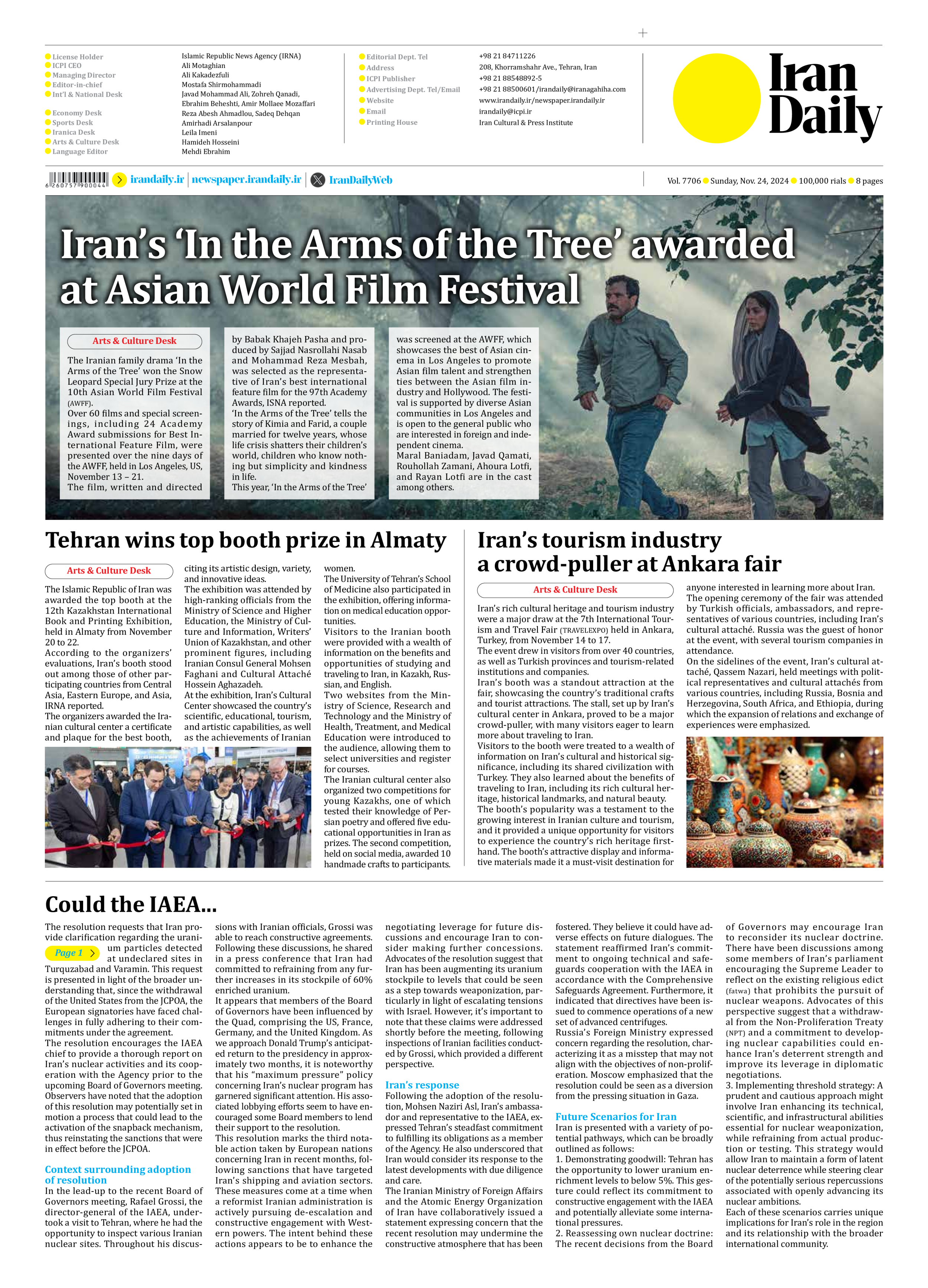
Could the IAEA...
Page 1
The resolution requests that Iran provide clarification regarding the uranium particles detected at undeclared sites in Turquzabad and Varamin. This request is presented in light of the broader understanding that, since the withdrawal of the United States from the JCPOA, the European signatories have faced challenges in fully adhering to their commitments under the agreement.
The resolution encourages the IAEA chief to provide a thorough report on Iran’s nuclear activities and its cooperation with the Agency prior to the upcoming Board of Governors meeting. Observers have noted that the adoption of this resolution may potentially set in motion a process that could lead to the activation of the snapback mechanism, thus reinstating the sanctions that were in effect before the JCPOA.
Context surrounding adoption of resolution
In the lead-up to the recent Board of Governors meeting, Rafael Grossi, the director-general of the IAEA, undertook a visit to Tehran, where he had the opportunity to inspect various Iranian nuclear sites. Throughout his discussions with Iranian officials, Grossi was able to reach constructive agreements. Following these discussions, he shared in a press conference that Iran had committed to refraining from any further increases in its stockpile of 60% enriched uranium.
It appears that members of the Board of Governors have been influenced by the Quad, comprising the US, France, Germany, and the United Kingdom. As we approach Donald Trump’s anticipated return to the presidency in approximately two months, it is noteworthy that his “maximum pressure” policy concerning Iran’s nuclear program has garnered significant attention. His associated lobbying efforts seem to have encouraged some Board members to lend their support to the resolution.
This resolution marks the third notable action taken by European nations concerning Iran in recent months, following sanctions that have targeted Iran’s shipping and aviation sectors. These measures come at a time when a reformist Iranian administration is actively pursuing de-escalation and constructive engagement with Western powers. The intent behind these actions appears to be to enhance the negotiating leverage for future discussions and encourage Iran to consider making further concessions.
Advocates of the resolution suggest that Iran has been augmenting its uranium stockpile to levels that could be seen as a step towards weaponization, particularly in light of escalating tensions with Israel. However, it’s important to note that these claims were addressed shortly before the meeting, following inspections of Iranian facilities conducted by Grossi, which provided a different perspective.
Iran’s response
Following the adoption of the resolution, Mohsen Naziri Asl, Iran’s ambassador and representative to the IAEA, expressed Tehran’s steadfast commitment to fulfilling its obligations as a member of the Agency. He also underscored that Iran would consider its response to the latest developments with due diligence and care.
The Iranian Ministry of Foreign Affairs and the Atomic Energy Organization of Iran have collaboratively issued a statement expressing concern that the recent resolution may undermine the constructive atmosphere that has been fostered. They believe it could have adverse effects on future dialogues. The statement reaffirmed Iran’s commitment to ongoing technical and safeguards cooperation with the IAEA in accordance with the Comprehensive Safeguards Agreement. Furthermore, it indicated that directives have been issued to commence operations of a new set of advanced centrifuges.
Russia’s Foreign Ministry expressed concern regarding the resolution, characterizing it as a misstep that may not align with the objectives of non-proliferation. Moscow emphasized that the resolution could be seen as a diversion from the pressing situation in Gaza.
Future Scenarios for Iran
Iran is presented with a variety of potential pathways, which can be broadly outlined as follows:
1. Demonstrating goodwill: Tehran has the opportunity to lower uranium enrichment levels to below 5%. This gesture could reflect its commitment to constructive engagement with the IAEA and potentially alleviate some international pressures.
2. Reassessing own nuclear doctrine: The recent decisions from the Board of Governors may encourage Iran to reconsider its nuclear doctrine. There have been discussions among some members of Iran’s parliament encouraging the Supreme Leader to reflect on the existing religious edict (fatwa) that prohibits the pursuit of nuclear weapons. Advocates of this perspective suggest that a withdrawal from the Non-Proliferation Treaty (NPT) and a commitment to developing nuclear capabilities could enhance Iran’s deterrent strength and improve its leverage in diplomatic negotiations.
3. Implementing threshold strategy: A prudent and cautious approach might involve Iran enhancing its technical, scientific, and infrastructural abilities essential for nuclear weaponization, while refraining from actual production or testing. This strategy would allow Iran to maintain a form of latent nuclear deterrence while steering clear of the potentially serious repercussions associated with openly advancing its nuclear ambitions.
Each of these scenarios carries unique implications for Iran’s role in the region and its relationship with the broader international community.







